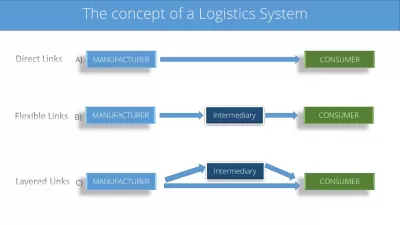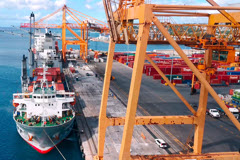The Concept Of A Logistics System
The logistics system is an essential element for a successful business
Today, it is relevant that the logistics system is an integral element for the stable functioning of a business in today's market conditions.
A logistics system is a complex organizationally completed economic system that consists of subsystems interconnected in a single process of managing financial, personnel, material, information, service and related flows, and the tasks of functioning of these links are united by the internal goals of the business organization and external goals.
Let us consider in more detail the concept of a logistics system, its purpose, properties and types.
The concept of a logistics system
There are various systems that ensure the functioning of the economic mechanism. In this set, it is necessary to single out the logistics systems in order to analyze and improve them.
The generally accepted definition of a logistics system says that a logistics system is an adaptive feedback system that performs certain logistics functions. It, as a rule, consists of several subsystems and has developed connections with the external environment.
The purpose of the logistics system is the delivery of goods and products to a given place, in the right quantity and assortment, prepared to the maximum extent possible for industrial or personal consumption at a given level of costs.
The logistics system is characterized by a number of properties:
- compatibility of elements of the system (ensured by the unity of ultimate goals);
- the relationship of the elements of the logistics system (in external systems, the relationship is ensured by the conclusion of an agreement between the parties, in the internal logistics system, the relationship is provided by intra-production relations of the elements);
- the connection between the elements of the system, which have a certain orderliness, organization;
- an integral property (not a single element of the system individually is able to perform the functions of the system, i.e. procurement, production and marketing with minimization of total costs; each element of the system can work and achieve the ultimate logistical goal only in conjunction with other elements).
The objects of the logistics system are enterprises and organizations that have a bank account, their own seal, an independent balance sheet (industrial, construction, transport, supply and marketing organizations); glossings (regional and interregional complexes - fuel and energy, energy systems and associations, etc).
All objects operating outside the logistics system belong to the external environment and are included in other logistics systems.
Macrologistic and Micrologistic systems
In many sources, logistics systems are divided into macrologistics and micrologistics.
The macrologistic system is a large material flow management system, covering industrial enterprises and organizations, intermediary, trade and transport organizations of various departments located in different regions of the country. The macrologistic system is a certain infrastructure of the economy of a region, country or group of countries. When forming a macro-logistics system covering different countries, it is necessary to overcome the difficulties associated with the legal and economic features of international economic relations, with unequal conditions for the supply of goods, differences in the transport legislation of countries, as well as a number of other barriers. The formation of macro-logistics systems in interstate programs requires the creation of a single economic space, a single market without internal borders, customs barriers to the transportation of goods, capital, information, and labor resources.
Micrologistics systems are subsystems, structural components of macrologistics systems. These include various industrial and commercial enterprises, territorial production complexes. Micrologistics systems are a class of intra-production logistics systems, which include technologically related industries, united by a single infrastructure.
Types of logistics systems by connections
There are three types of logistics systems: logistics systems with direct links, flexible and layered.
Logistics system with direct connections. The material flow passes directly from the producer of products to the consumer (for example, the production and consumption of electricity).
Layered logistics system. There is at least one intermediary on the path of the material flow. For example, a wholesale base of electronic elements of computer technology.
Flexible logistics system. The movement of material flow from the producer to the consumer can be carried out both directly and through an intermediary. For example, deliveries from a metallurgical plant are carried out on orders to large machine-building enterprises, and also go to a wholesale base for sale to small and medium-sized enterprises.
Summarizing data on logistics systems
From the point of view of systems theory, a logistics system is an adaptive feedback system that performs certain logistics functions and operations. The logistics system can consist of several subsystems and has developed links with the external environment.
The logistics system is an essential element for the stable functioning of the enterprise in today's market conditions.
This is a complex organizational economic system, which consists of subsystems interconnected in a single process of managing financial, personnel, material, information, service and related flows in all types of logistics systems.As a logistics system, various enterprises can be considered - industrial, trade, transport, financial, intermediary and their complexes.
The logistics system, like any other system, has certain properties:
- Integrity - the internal relationship of parts of the system with a single purposeful activity. The basis of integrity is the close interconnection of individual parts.
- Autonomy - the ability of the system to function and develop within a fairly wide range, regardless of the environment.
- Internal connections - the elements of the system are connected with each other, while the connections between the elements of the system are stronger than the connections of the elements of the system with the external environment. Internal links are ordered in a certain way, i.e. form the structure of the system.
- The complexity of the system is determined by the number of elements, the nature of their interaction, the complexity of the functions performed, environmental factors, etc.
- Interaction with the environment.
The hallmarks of a logistics system are the presence of a streaming process and system integrity.
Frequently Asked Questions
- What are the fundamental components of a logistics system as discussed in this article?
- This article outlines the fundamental components of a logistics system, including transportation, warehousing, inventory management, order processing, and the integration of these components for efficient goods movement and supply chain management.

Freelancer, author, website creator, and SEO expert, Elena is also a tax specialist. She aims at making quality information available to the most, to help them improve both their personal and professional lives.

